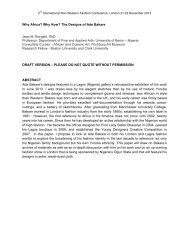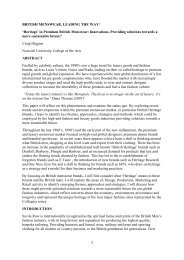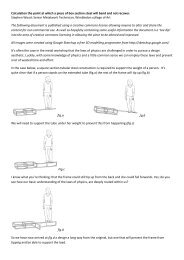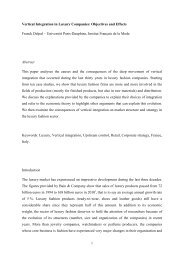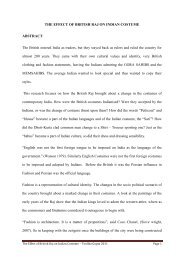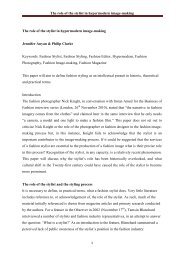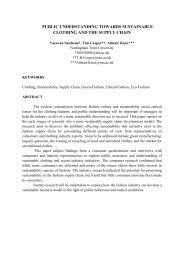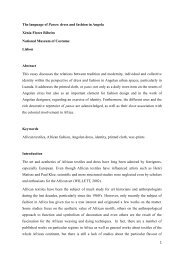1 Abstraction and idealization: the case of Futurist and ... - Arts
1 Abstraction and idealization: the case of Futurist and ... - Arts
1 Abstraction and idealization: the case of Futurist and ... - Arts
You also want an ePaper? Increase the reach of your titles
YUMPU automatically turns print PDFs into web optimized ePapers that Google loves.
The Italian word „tutta‟, meaning „<strong>the</strong> whole, <strong>the</strong> entire‟, becomes in <strong>the</strong> brochure „tuta‟, for<strong>the</strong> missing consonant „t‟ can be found in <strong>the</strong> T-shape <strong>of</strong> <strong>the</strong> garment itself. The idea <strong>of</strong>totality, contained in <strong>the</strong> word „tutta‟, is unequivocally at <strong>the</strong> origin <strong>of</strong> <strong>the</strong> tuta that, in itsmaterialization, refers to <strong>the</strong> totality <strong>of</strong> <strong>the</strong> fabric <strong>and</strong> <strong>of</strong> <strong>the</strong> wearer; at <strong>the</strong> same time, <strong>the</strong> idea<strong>of</strong> collectivity (<strong>the</strong> totality <strong>of</strong> <strong>the</strong> people) is introduced, <strong>and</strong> in turn evokes <strong>the</strong> sameappearance <strong>of</strong> <strong>the</strong> people dressed in tuta. Unfolding <strong>the</strong> various layers <strong>of</strong> meaning, <strong>the</strong> three„t‟ in <strong>the</strong> word „tuta‟ could also hint at <strong>the</strong> concept <strong>of</strong> „trinity‟, while at <strong>the</strong> same time <strong>the</strong> techoes per se <strong>the</strong> Tau, a symbol for <strong>the</strong> absolute, <strong>the</strong> perfection <strong>of</strong> creation, <strong>the</strong> summary <strong>of</strong>everything in everything. The special attention given to <strong>the</strong> name is typical <strong>of</strong> ErnestoMichahelles who chose for himself a bifrontal palindrome as pseudonym. Thayaht, whostudied esoteric art <strong>and</strong> <strong>the</strong>osophy, found <strong>the</strong>n in <strong>the</strong> graphic expedient <strong>of</strong> <strong>the</strong> lost „T‟ <strong>the</strong>baptizing act <strong>of</strong> his sartorial invention.Since <strong>the</strong>n, <strong>the</strong> neologism „tuta‟ has permanently entered <strong>the</strong> Italian vocabulary, meaning agarment (ei<strong>the</strong>r overall or composed <strong>of</strong> a jacket <strong>and</strong> trousers) generally used to practicesports, or worn by workmen as mechanics, fabric workers, aviators, military <strong>of</strong>ficers etc.The tuta created by Thayaht was suitable for everyone <strong>and</strong> every occasion: it was a„universal‟ garment, xx extremely simple to realize, <strong>and</strong> particularly cheap. If 1 metre <strong>of</strong> cottonor hemp cloth was sold at <strong>the</strong> price <strong>of</strong> circa 7 liras, <strong>the</strong> confection <strong>of</strong> <strong>the</strong> tuta required in totalless than 50 liras, against <strong>the</strong> 100/150 liras usually necessary to buy an ordinary cottongarment. xxi It contemplated different variants <strong>of</strong> colour, but excluded any decorative element,featuring just 4 pockets, 7 buttons on <strong>the</strong> front, <strong>and</strong> a simple collar. It could be worn with abelt, <strong>and</strong> no shirt underneath, being originally a summer outfit. The photos <strong>of</strong> <strong>the</strong> time showThayaht with a walking stick, elegantly dressed in tuta, <strong>and</strong> wearing cutout Florentines<strong>and</strong>als, xxii which he invented, or T-bar „Forte dei Marmi‟ s<strong>and</strong>als. [Image 7] Indeed, <strong>the</strong> tutawas a garment tout court, for everyday life as well as for special occasions. That <strong>the</strong> tuta wasconceived for <strong>the</strong> masses is demonstrated by <strong>the</strong> specific choice <strong>of</strong> publication in «LaNazione», one <strong>of</strong> <strong>the</strong> first <strong>and</strong> most read newspapers <strong>of</strong> <strong>the</strong> times. Such a revolutionaryinvention, without being restricted to <strong>the</strong> elitarian world <strong>of</strong> haute couture, was destined toinfluence contemporary life, <strong>and</strong> <strong>the</strong>refore represents a significant step forwards in <strong>the</strong>direction <strong>of</strong> a democratization <strong>of</strong> fashion. Not by chance Thayaht is considered a precursor <strong>of</strong>numerous aspects <strong>of</strong> contemporary life <strong>and</strong> creativity. xxiiiIn Florence <strong>the</strong> tuta became very popular, <strong>and</strong> galas „in tuta‟ were regularly organized byFlorentine aristocratic families. In Rome <strong>and</strong> Milan, recalls historian Giovanna Uzzani,noblewomen, actresses <strong>and</strong> socialites, eager to adopt unusual looks, were among <strong>the</strong> first tobuy <strong>and</strong> order <strong>the</strong> tuta. xxiv Just few weeks after <strong>the</strong> publication <strong>of</strong> <strong>the</strong> first pattern by «LaNazione» more than one thous<strong>and</strong> <strong>of</strong> people adopted <strong>the</strong> tuta, which was appropriatelyconsidered <strong>the</strong> most provocative garment <strong>of</strong> <strong>the</strong> summer 1920. xxv The feminine version wasvery similar to <strong>the</strong> masculine one: it came in solid colour, had four pockets on <strong>the</strong> front, acollar <strong>and</strong> a belt almost identical to those <strong>of</strong> <strong>the</strong> male tuta. The only difference resided in <strong>the</strong>fact that it featured no trousers but was a sort <strong>of</strong> sack dress. The tuta for women representedin fact a fur<strong>the</strong>r simplification <strong>of</strong> <strong>the</strong> already very linear female clothing, <strong>and</strong> utilized nocostly materials. xxvi As vehemently argued by Thayaht <strong>and</strong> <strong>the</strong> o<strong>the</strong>r <strong>Futurist</strong>s, true elegancehas nothing to do with <strong>the</strong> quality <strong>of</strong> fabrics; hence women should abolish any vain <strong>and</strong> futileattention to exterior details, <strong>and</strong> ra<strong>the</strong>r concentrate on finding beauty in <strong>the</strong> absolutesimplicity. Thayaht even invites women to ab<strong>and</strong>on high heels, which are nothing else thanan anti-aes<strong>the</strong>tic <strong>and</strong> unhealthy fiction to increase height. xxvii Along <strong>the</strong> female <strong>and</strong> male tuta,in 1921 was created <strong>the</strong> bituta, that is, a tuta in two parts (a jacket <strong>and</strong> simplified trousers).This, says Thayaht, is even more practical than <strong>the</strong> tuta overall. Resulting from <strong>the</strong>experience generating <strong>the</strong> tuta, it represents in fact <strong>the</strong> perfected development <strong>of</strong> it. xxviiiIn <strong>the</strong> photographs <strong>of</strong> <strong>the</strong> time, Thayaht wears <strong>the</strong> bituta, appearing extremely elegant. xxix In4



